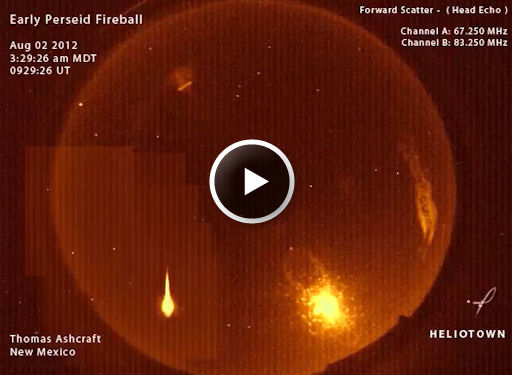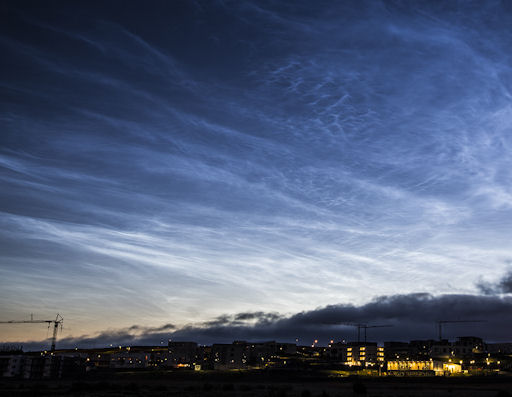Hang the Transit of Venus on your wall! Hubble-quality images from NASA's Solar Dynamics Observatory are now available as metallic posters in the Space Weather Store. | | |
CURIOSITY & SOLAR FLARES: Mars rover Curiosity has beeen hit by multiple solar flares en route to the Red Planet, giving NASA planners an idea of what faces human astronauts in the Earth-Mars expanse. [full story]
RIPPING PERSEID: As Earth enters a broad stream of debris from Comet Swift-Tuttle, more and more Perseid meteors are appearing in the night sky. "Last night, I captured a Perseid fireball ripping through the ionosphere over New Mexico," reports amateur astronomer Thomas Ashcraft. "It was traveling pretty fast - 133,000 miles per hour!" Click to see and hear the meteoroid disintegrate:

The movie's sound track comes from Ashcraft's dual-frequency meteor radar. It works like this: Radio signals from distant VHF transmitters bounce off the meteor's ion trail. Ashcraft's antennas can pick up those reflections, which sound like ghostly echoes in the loudspeaker of his VHF receiver.
At the moment, Perseid meteor rates are low--no more than about 10 per hour. In the days ahead, however, Earth will plunge deeper into the comet's debris stream, and meteor activity will increase accordingly. Forecasters expect the shower to peak on August 12-13 with as many as 100+ meteors per hour visible from dark-sky sites. Stay tuned for Perseids.
Realtime Meteor Photo Gallery
ELECTRIC-BLUE CLOUDS: A bank of electric-blue noctiluent clouds swept across Iceland on August 2nd, producing a vivid display of luminous ripples and tendrils over Reykjavik:

"These are the highest clouds in Earth's atmosphere, located at altitudes of around 76 to 85 kilometres," says photographer Iurie Belegurschi. "It was a beautiful display."
New data from NASA's AIM spacecraft prove that noctilucent clouds (NLCs) are seeded by space dust. The tiny ice crystals that NLCs are made of nucleate around "meteor smoke" wafting through the upper reaches of Earth's atmosphere. Not only do these clouds look alien, they really are alien. A new video from NASA explains the research.
Realtime Noctilucent Cloud Photo Gallery
[previous years: 2003, 2004, 2005, 2006, 2007, 2008, 2009, 2011]
Realtime Space Weather Photo Gallery
Potentially Hazardous Asteroids (
PHAs) are space rocks larger than approximately 100m that can come closer to Earth than 0.05 AU. None of the known PHAs is on a collision course with our planet, although astronomers are finding
new ones all the time.
On August 3, 2012 there were potentially hazardous asteroids.
Notes: LD means "Lunar Distance." 1 LD = 384,401 km, the distance between Earth and the Moon. 1 LD also equals 0.00256 AU. MAG is the visual magnitude of the asteroid on the date of closest approach. | | The official U.S. government space weather bureau |
| | The first place to look for information about sundogs, pillars, rainbows and related phenomena. |
| | Researchers call it a "Hubble for the sun." SDO is the most advanced solar observatory ever. |
| | 3D views of the sun from NASA's Solar and Terrestrial Relations Observatory |
| | Realtime and archival images of the Sun from SOHO. |
| | from the NOAA Space Environment Center |
| | the underlying science of space weather |

